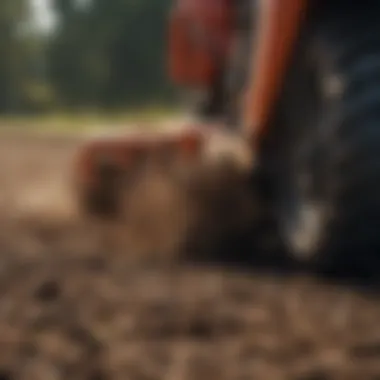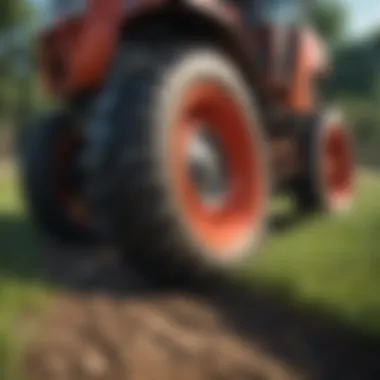Utilizing Rototillers for Effective Grass Management


Intro
In the realm of agricultural management, the efficiency of grass cultivation plays a significant role. Rototillers serve as a vital tool in this process, offering unique benefits in terms of soil preparation, weed control, and fostering healthy grass systems. Understanding how to effectively utilize rototillers can enhance not only the quality of grass but also the overall productivity of land dedicated to this purpose. By delving into the mechanics of rototilling and assessing its advantages and disadvantages, farmers and enthusiasts alike can make informed choices on how to leverage this equipment in their grass management strategies.
Key Concepts and Terminology
Basic Definitions
A rototiller is a gardening implement that uses rotating blades or tines to break up soil, enabling the mixing and aeration of soil components. It is often used for preparing garden beds, but its application extends into grass management as well. Key terms associated with rototilling include:
- Tines: These are the metal blades that rotate and churn the soil.
- Soil aeration: The process of creating air pockets in the soil, which helps roots access oxygen.
Historical Context
The use of tillage tools dates back centuries. Initially, farmers relied on manual methods or animal-driven ploughs. As technology advanced, the introduction of motorized rototillers revolutionized land preparation by increasing efficiency and reducing labor. Nowadays, this piece of equipment is indispensable for any serious grass management plan.
Recent Innovations and Trends
Technological Advancements
Modern rototillers have seen various upgrades. These include electric-powered options, which offer quieter operation and ease of use. Additionally, advancements in design have improved maneuverability and reduced wear and tear on the equipment, further enhancing productivity on the field.
Sustainable Practices
Sustainable agriculture increasingly emphasizes the importance of soil health. Rototillers can support these practices by promoting better soil structure through aeration. By enabling microbes and organic matter to thrive, farmers can improve nutrient availability and enhance soil fertility naturally.
Practical Applications and Techniques
Step-by-step Guides
- Preparation: Assess the area for weeds and debris. Clear the space to ensure optimal efficiency for the tiller.
- Selecting the Tiller: Choose a rototiller that fits your needs—garden size, power source (gas or electric), and tine type.
- Adjusting Settings: Set the depth of the tines according to the type of grass you are cultivating.
- Tilling Process: Start the tiller in a straight line. Overlap passes for a uniform texture. Repeat until soil is evenly churned.
- Seeding: Once tilling is complete, proceed to plant grass seeds, following recommended sowing rates and methods.
Case Studies
Farmers who have integrated rototillers into their grass management practices report significant gains in efficiency. For instance, a local farmer in Indiana utilized a rototiller to prepare a 1-acre plot for a new lawn. By using the tiller, they reduced preparation time by 50%, allowing for quicker planting and establishment of a healthy grass system.
"The rototiller has transformed how I manage my grass areas. It saves time and improves growth significantly." — Indiana Farmer
Prologue to Rototillers
The use of rototillers plays a critical role in grass management. They are essential tools for soil preparation, weed control, and fostering healthy grass growth. Understanding how to utilize rototillers effectively can significantly enhance the outcome of grass cultivation efforts.
Definition and Purpose
Rototillers, also known as tillers or cultivators, are machines designed to break up soil, aerate it, and prepare it for planting. They work by using rotating blades, or tines, to mix soil with organic matter, thus improving its structure and nutrient content. This process is vital for creating a healthy environment for grass seeds to germinate and flourish. The primary purpose of a rototiller is to make soil work easier for farmers and gardeners, allowing them to manage larger areas efficiently.
Historical Context
The concept of tilling dates back thousands of years when farmers used simple tools like hoes and plows to turn the earth. Over time, technological advancements led to the emergence of motorized rototillers in the 20th century, revolutionizing agriculture and gardening. The development of these machines greatly improved efficiency in soil preparation, reducing the time and labor required. Today, rototillers come in various forms—gas-powered, electric, and manual—each catering to different land sizes and user preferences.
Mechanics of Rototillers
Understanding the mechanics of rototillers is crucial for anyone involved in grass management. This section provides insight into how these machines function and the different types available. Knowing the mechanics can lead to better efficiency and results when working on grass cultivation, soil preparation, and overall garden upkeep. This understanding also helps in making informed decisions about which type of rototiller best suits individual needs.
How Rototillers Work
Rototillers operate through a series of rotating metal blades, or tines, that dig into the soil. The tines break up compacted earth and create a loose texture, facilitating an environment favorable for grass seed germination and growth. When the tiller is driven forward, the tines cut through the ground, turning and aerating the soil in the process. The depth of tilling can usually be adjusted based on specific needs, which allows for versatile soil preparation strategies.


Types of Rototillers
Different models of rototillers cater to various needs, and understanding these can aid in selecting the right one.
Gas-powered Rototillers
Gas-powered rototillers are known for their power and performance. They are particularly effective in larger areas or for tough soil conditions. Their ability to handle more demanding tasks makes them a popular choice among farmers and gardeners who require a more robust tool. A unique feature of gas-powered models is their engine size, which contributes to their tilling force. However, this also comes at a cost; they emit exhaust fumes and require regular maintenance to keep the engine running efficiently.
Electric Rototillers
Electric rototillers offer a more environmentally friendly alternative to gas models. These machines are typically lighter and easier to handle, making them suitable for small to medium-sized gardens. They run quieter and produce no emissions during use. The key characteristic of electric rototillers is their plug-in or battery-operated design, allowing for convenient usage. However, they may not perform as well in dense or rocky soils, and their range is often limited by cord length or battery life.
Manual Rototillers
Manual rototillers require the least amount of power and are operated by hand. These tools consist of simple tines that can be pushed into the soil to break it up. The main advantage is their cost-effectiveness and ease of storage. They are ideal for small gardens or plots where precision is necessary. However, they demand a greater physical effort and take significantly longer to till large areas compared to mechanical options. Despite this, they provide excellent control over soil disturbance.
"Understanding the mechanics behind rototillers can enhance efficiency in grass management and promote healthier grass systems."
In summary, each type of rototiller has its strengths and weaknesses, making the choice largely dependent on individual project requirements and preferences.
Benefits of Using Rototillers for Grass
The utilization of rototillers in grass management is pivotal due to several inherent benefits. These benefits significantly enhance the quality and growth of grass systems, making them a valuable tool for farmers and land caretakers. By thoroughly understanding these advantages, one can appreciate how rototillers contribute not only to grass establishment but also to the long-term health of the soil environment.
Soil Aeration
Soil aeration is an essential process that involves creating air spaces in the soil. Rototillers effectively break up compacted layers, allowing air to penetrate deeper into the soil profile. This improved aeration facilitates the exchange of gases between the soil and the atmosphere, which is vital for root health.
Moreover, sufficient aeration promotes microbial activity that is beneficial for soil health. Microbes play a critical role in breaking down organic matter and releasing nutrients, further enhancing soil fertility. By aerating the soil with a rototiller, one can mitigate issues related to waterlogging and poor drainage that often hinder grass growth.
Weed Control
Another significant advantage of rototillers relates to weed control. Weeds compete for nutrients, light, and space, making them a troublesome aspect for any grass management effort. The tilling process disrupts the root systems of established weeds, effectively reducing their population. Rototillers can also help incorporate mulch and organic matter into the soil, which acts as a barrier to weed growth.
Implementing a tilling routine can significantly decrease the seed bank of persistent weeds. However, it is important to note that timely and proper tilling is crucial, as some weeds can quickly rebound if tilling is not executed at the correct stage of their growth cycle. Regular monitoring of fields can ensure weed control remains effective.
Nutrient Mixing
Nutrient mixing is a core benefit of using rototillers in grass management. When soil is tilled, various layers are mixed, allowing for a more uniform distribution of nutrients throughout the planting area. This homogeneity is crucial for creating a favorable growing environment, as grass roots can access nutrients more efficiently.
In addition, adding compost or fertilizers during the tilling process further enhances nutrient availability. The mixing action allows these materials to integrate into the soil effectively, ensuring that nutrients are not concentrated in one area but dispersed evenly. This practice not only promotes healthy grass growth but also establishes resilience against pests and diseases.
Effective soil management through rototilling can lead to long-term benefits for grass health and productivity.
In summary, using rototillers for grass management brings forth significant advantages such as enhanced soil aeration, improved weed control, and efficient nutrient mixing. Understanding these benefits allows for more informed decisions in managing grass systems effectively.
Challenges of Rototilling
The use of rototillers in grass management is not without its challenges. Understanding these potential drawbacks is critical for effective implementation. Farmers and enthusiasts must address these issues to maximize the benefits of rototilling. Awareness of the following challenges can lead to better planning and execution, ensuring that this tool aids rather than hinders grass management.
Soil Compaction
One significant challenge with rototilling is soil compaction. When heavy machinery compresses the soil surfaces, it limits the movement of water and air. Compacted soil can lead to poor root development, stunted plant growth, and increased runoff. The repeated use of rototillers can exacerbate this issue, especially if the soil is wet or dense. It is essential to monitor soil moisture levels before tilling. If the soil is too wet, it’s advisable to delay the process to avoid adding to compaction. Regular aeration practices can also help mitigate soil compaction, making it easier for roots to penetrate the soil.
Erosion Risks
Another risk associated with rototilling is soil erosion. Tilling disrupts the soil structure, which can lose its ability to hold onto nutrients and moisture. When the upper layer of soil is disturbed, it becomes susceptible to wind and water erosion. In regions where rainfall is frequent, the risk of erosion increases significantly. Farmers should consider implementing contour tilling or no-till practices to reduce erosion. Establishing cover crops can also aid in holding the soil together, preventing erosion post-tilling. Awareness of the land’s topography can further inform how tilling is done to minimize erosion risks.
Cost Considerations


Finally, the costs associated with rototilling should not be overlooked. While rototillers can improve grass management, the initial investment for a quality machine is considerable. Additionally, maintenance costs, fuel expenses, and hiring labor can add up over time. Implementing a rototilling schedule that optimizes usage can help control these expenditures. Evaluating the long-term benefits, such as improved grass health and productivity, can assist in justifying the costs. Farmers must balance these financial aspects with the overall effectiveness of their grass management strategies to make informed decisions.
Proper Techniques for Using Rototillers
Using rototillers in grass management requires more than just an understanding of the machine itself. Proper techniques ensure that the rototilling process promotes healthy grass growth and prevents potential issues down the line. This section highlights key elements, benefits, and considerations necessary for effective rototilling.
Preparation of the Site
Before starting to till, preparing the site is crucial. This includes clearing away any debris, rocks, or obstacles from the area. Not only does this help in effective tilling, but it also reduces the risk of equipment damage. Clearing the site also minimizes the chances of injury for the operator. Additionally, testing the soil for pH and nutrient levels can be beneficial. This allows for targeted amendments, ensuring the soil is ready for grass growth.
- Clear obstacles: Remove sticks, stones, and other debris.
- Test soil conditions: Check pH and nutrient levels using a simple soil test kit.
- Improve drainage: If the area has poor drainage, consider addressing it before tilling.
Taking these steps ensures that you create a suitable environment for rototilling and, ultimately, grass establishment.
Optimal Tilling Depth
Determining the correct tilling depth is essential for achieving the desired results. Generally, a depth of 6 to 8 inches is effective for most types of grasses. However, the ideal depth might vary based on soil composition and grass type. Too shallow might not adequately aerate the soil, while too deep can lead to soil compaction underneath.
When deciding on depth, consider:
- Soil type: Sandy soils may require less depth, while clay soils might need more.
- Grass species: Some grasses have deeper root systems than others.
- Seasonal factors: Wet soil conditions can complicate the tilling depth.
By tilling to the right depth, you ensure that the roots can penetrate easily and grow robustly.
Tilling Patterns
The pattern in which you till can significantly impact the effectiveness of your efforts. Following a systematic pattern can enhance soil aeration, encourage better drainage, and promote even soil mixing. Common patterns include straight lines or circular motions. However, regardless of the pattern, cross-tilling is often recommended. This technique involves making passes over the same area at different angles, ensuring thorough soil mixing and reducing compacting of soil layers.
- Straight lines: Simple and easy to follow, providing a straightforward approach.
- Circular patterns: Can improve soil mixing but may require more effort to maintain consistency.
- Cross-tilling: Involves passing over the area at 90-degree angles, optimizing mixing.
Properly planning your tilling pattern is an overlooked aspect that can yield significant benefits for grass establishment.
Taking the time to prepare the site, decide on the optimal tilling depth, and choose effective tilling patterns can greatly enhance the outcome of grass management efforts.
In summary, using rototillers effectively in grass management is a careful mixture of preparation, depth considerations, and strategic patterns. Each of these factors plays a role in creating an environment conducive to healthy grass growth.
Maintenance of Rototillers
Proper maintenance is crucial for the effective operation of rototillers. The longevity and performance of these machines depend significantly on how well they are cared for. Neglecting maintenance can lead to poor efficiency, breakdowns, and ultimately financial losses. Thus, understanding maintenance routines is beneficial for both the user and the machinery.
Routine Inspections
Routine inspections are fundamental in maintaining a rototiller's functionality. These inspections should occur before and after each use. Check for any visible damage, including cracks or wear on the body and tines. Ensuring that all nuts and bolts are tightly secured can prevent mishaps during operation.
Additionally, inspect the fuel system to confirm there is no leakage and that the fuel is fresh. Regularly examining the air filters helps to maintain optimal air flow for the engine, enhancing performance.
Consider creating a checklist to simplify the routine inspection process. Some key aspects to include are:
- Checking oil levels and quality
- Inspecting belts for wear
- Cleaning dirt and debris build-up
Sharpening Tines
Sharpening the tines is an essential maintenance task. Dull tines can reduce the effectiveness of a rototiller, making it harder to break up soil and manage the grass properly. Routine sharpening ensures that the machine can efficiently aerate the soil and remove weeds.
The process typically requires a file or bench grinder. First, remove the tines from the rototiller, and then clean them to remove any dirt or residue. Once clean, proceed to sharpen them, maintaining the original cutting angle. It is advisable to check the manufacturer's specifications for the correct sharpening technique. This maintenance task should be performed at least once a season, depending on the usage frequency.
Storing and Winterizing
Proper storage and winterization of rototillers are vital for preserving their condition. At the end of the growing season, it is crucial to clean the machine thoroughly to remove any soil or plant material that could cause rust or damage over time. After cleaning, the next step is to drain the fuel tank or add a fuel stabilizer to prevent fuel degradation.


Storing the rototiller in a dry area protects it from moisture and weather-related wear. Utilize a cover to shield the machine from dust and debris. Inspection of the battery, if applicable, ensures it is adequately charged and free from corrosion. Lastly, check the oil and filters before the first use in spring; changing oil after winter storage helps maintain engine health.
Safety Considerations
Safety is a pivotal aspect when using rototillers for grass management. These machines, while beneficial for soil preparation and weed control, can pose risks if proper precautions are not taken. A lack of safety measures can lead to accidents that may cause serious injuries or damage to property. Therefore, both novice and experienced users should understand and implement safety considerations adequately.
Personal Protective Equipment
Personal protective equipment (PPE) is essential for anyone operating a rototiller. The right gear minimizes risk and promotes safer working conditions. Key items include:
- Safety Goggles: Protects eyes from dust and debris when tilling.
- Gloves: Provides grip on the tiller handles and protects against blisters.
- Sturdy Boots: Offers protection for feet from heavy equipment and sharp objects, as well as slip resistance.
- Ear Protection: Useful for reducing noise exposure from gas-powered machines, which can be quite loud.
- Dust Masks: Prevents inhalation of harmful dust, especially when working in dry soil conditions.
Using the right PPE not only keeps the operator safe but also ensures compliance with safety regulations in many jurisdictions. It's important to ensure that equipment is in proper working order before use, further enhancing safety during operation.
Operational Precautions
Implementing operational precautions is vital for safe tilling practices. Consider the following guidelines:
- Read the Manual: Familiarize yourself with the specific instructions provided by the manufacturer of your rototiller before use.
- Inspect the Equipment: Regularly check for any wear and tear that could lead to mechanical failure.
- Clear the Area: Before tilling, ensure the work area is free of rocks, branches, and other debris that could cause injury or damage.
- Maintain Awareness: Be aware of your surroundings, including other people and animals. Avoid distractions while operating the tiller.
- Avoid Slopes: Do not operate on steep slopes as this increases the risk of losing control.
- Follow Electrical Safety: For electric rototillers, ensure cords are kept clear of the rototilling area to prevent tripping or accidental unplugging.
"Safety is not just a priority; it is a commitment that underpins the effective use of rototillers in grass management."
By following these safety measures, individuals can significantly mitigate risks associated with rototilling. Engaging in safe practices not only protects the operator but also ensures effective and efficient grass management operations.
Integrating Rototillers into Grass Management Plans
Integrating rototillers into grass management plans is crucial for achieving optimal results in both soil health and grass cultivation. This process involves more than just using the tool; it requires careful consideration of how, when, and why tilling should occur. By understanding the specific elements that influence grass growth and soil condition, farmers can use rototillers to enhance their agricultural practices effectively. Doing so also helps to ensure a sustainable approach to grass management over the long term.
Assessing Soil Conditions
Before employing a rototiller, assessing soil conditions is paramount. This means examining factors like pH levels, moisture content, and soil structure. Healthy soil is often well-aerated, contains organic matter, and provides essential nutrients for grass.
To evaluate soil conditions:
- Conduct a Soil Test: Use a soil testing kit to check for pH and nutrient levels. This helps establish what amendments may be needed.
- Observe Physical Characteristics: Inspect the soil for compacted areas or poor drainage, which can impact grass growth.
- Determine Moisture Levels: Understanding how wet or dry the soil is can influence tilling decisions. Ideally, soil should be moist but not soggy.
Evaluating these conditions enables farmers to make informed decisions about when and how to use a rototiller effectively, ensuring maximum benefit to the grass and the soil.
Creating a Rototilling Schedule
A well-thought-out rototilling schedule can significantly influence the success of grass management. Timing is often as important as technique. Establishing a schedule allows for the planned integration of rototilling into the natural growth cycles of grass.
When defining a rototilling schedule:
- Seasonal Considerations: The best time to till is often in early spring or late fall, depending on the regional climate and grass type.
- Grass Growth Cycles: Understand when grass is growing actively. Avoid tilling during peak growth periods as this can stress the plants.
- Frequency of Tilling: Over-tilling can disrupt soil structure. Limiting tilling to once or twice a year, depending on needs, can preserve soil health.
A clear schedule helps in coordinating other aspects of grass management, ultimately leading to a more effective cultivation strategy.
"Effective management is not about doing more, but about doing the right things at the right times."
With a focus on integrating rototillers through proper assessment and scheduling, farmers and enthusiasts alike can optimize their grass management plans, bringing about healthier ecosystems and improved agricultural outcomes.
Epilogue
In this article, we have examined the vital role that rototillers play in grass management. Understanding their capabilities and advantages can significantly enhance soil health and grass cultivation. Utilizing rototillers helps to prepare the soil effectively by improving aeration, breaking up compacted earth, and integrating organic matter. This not only boosts growth potential for grass but also ensures a healthier ecosystem within the soil.
Summary of Key Points
- Soil Preparation: Rototillers prepare the ground by turning and mixing the soil, allowing roots to penetrate better and access nutrients more efficiently.
- Weed Management: Regular tilling disrupts weed growth by uprooting them and exposing seeds, ultimately contributing to better control over invasive plant species.
- Nutrient Distribution: Mixing organic matter like compost with soil enhances nutrient availability and supports vigorous grass growth.
- Considerations for Use: While rototillers offer various benefits, it is important to consider potential downsides such as soil compaction and erosion if not handled properly.
Future of Rototilling in Grass Management
Looking ahead, the future of rototilling in grass management appears promising. As agricultural technologies advance, we expect to see improvements in rototiller efficiency, making them more effective for diverse soil types and conditions. Environmental concerns are likely to drive the development of more sustainable tilling practices, reducing the impact of erosion and promoting soil conservation.
Innovation in electric and hybrid rototillers may gain popularity, appealing to those focused on reducing carbon footprints while maintaining gardens and lawns. Increasing awareness about soil health is pushing both amateur gardeners and professional farmers to adopt these tools into their regular practices. As education and resources improve, the effective integration of rototillers into grass management strategies will no doubt become more commonplace among enthusiasts and professionals alike.















